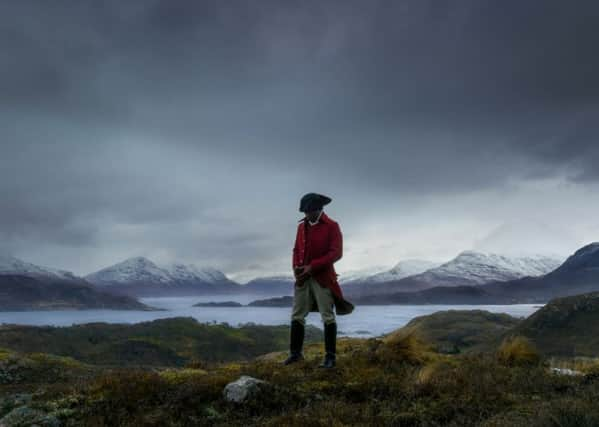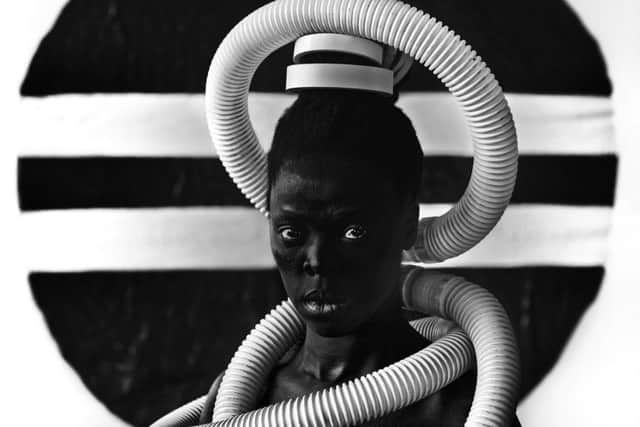Art reviews: John Akomfrah at Talbot Rice | Zanele Muholi at GSA


John Akomfrah: Vertigo Sea, Talbot Rice Gallery, Edinburgh ****
Zanele Muholi: Somnyama Ngonyama – Hail the Dark Lioness, Reid Gallery, Glasgow School of Art ****
Advertisement
Hide AdAdvertisement
Hide AdThere is an unashamed nod to the romantic tradition (the film is subtitled “Oblique Tales from the Aquatic Sublime”), with majestic film of waves and weather, and sumptuous wildlife footage purloined from the BBC Natural History Unit (aficionados of Planet Earth will have a few deja-vu moments). This is spliced with archival and documentary footage and a poetic soundtrack with snatches of Herman Melville and Virginia Woolf mingled with Akomfrah’s own historical research.


A founder member of the Black Audio Film Collective (BAFC) in the 1980s, Akomfrah honed his style of visual storytelling on work like Handsworth Songs: collaged footage, fragmentary stories, the excavation of a half-buried post-colonial past. And so it is with his study of the sea, the theatre in which some of our worst inhumanities have played out, from the horrors of the slave trade to the bodies of migrants and refugees washed up on beaches today. The sea, it seems, is where we make inconvenient people disappear, from the Zong massacre of 1781, when 133 slaves were thrown overboard so the traffickers could claim the insurance, to the political prisoners of Pinochet’s Chile, whose bodies were dropped from planes into the South Atlantic 200 years later.
Among these crashing waves of imagery and information, there are still moments in which Tarkovsky-esque figures stand on shores (filmed in Skye, the Faroe Islands and Norway) surrounded by fragments of domestic furniture – a pram, a chair, a bedstead. Dressed in period costume, they appear as silent witnesses to troubled histories, and – although Akomfrah doesn’t reference it directly – they made me think of nothing so much as victims of the Clearances waiting for ships to take them to the New World.
The sea is where we witness some of the world’s greatest natural wonders, the most dramatic weather, the strangest creatures. It is also where nature is particularly vulnerable: archival footage of whales being harpooned and polar bears shot is mingled with contemporary concerns about pollution and over-fishing. Vertigo Sea doesn’t pick and choose among these things, it embraces all of them; they swirl together in a watery drama of gorgeous visuals and heightened sensations, and it takes all Akomfrah’s skill to harness them into a structure which is sufficiently strong that the viewer isn’t overwhelmed.
Akomfrah further ackowledges his debt to his avant-garde Russian predecessor in the second film at Talbot Rice, At the Graveside of Tarkovsky. Viewers in the transformed Georgian Gallery stand on a carpet of pebbles next to a huge monolith: a graveyard indeed. A series of melancholic, unpeopled landscapes filmed on Skye and Hawaii drift across the big screen while the soundtrack of voices, re-made for Edinburgh into a three-dimensional soundscape, whispers and laments on the edge of hearing.


The effect of the installation as a whole is to evoke a place of ghosts, of half-buried, troubling histories. Perhaps they are emblematic of the voices of Akomfrah’s own history (his parents were political exiles from Ghana), or the post-colonial history of people of colour the world over: injustice and sadness never properly brought into the light. Here, he casts his viewers in the role of Tarkovsky’s silent witnesses, not always understanding what we see or hear, but honouring its importance with our presence.
South African artist Zanele Muholi take a different approach to black history. She prefers to call herself a “visual activist” and the striking body of photographic portraits at Glasgow School of Art’s Reid Gallery, shown at Autograph ABP in London earlier this year, confronts issues of the representation of black people with anger, humour and inventiveness.
Advertisement
Hide AdAdvertisement
Hide AdStepping into the gallery, you could be forgiven for thinking you have found the black Cindy Sherman. Muholi’s photographs are all self-portraits, capturing different moods and moments, poignant, shape-shifting, often beautiful. But, unlike Sherman, Muholi’s concern is less with the malleability of individual identity as with engaging with issues of identity as it is objectified according to race.
The props she uses to create her costumes are political ones: clothes pegs or latex gloves signify black South Africans who lived lives of domestic servitude under Apartheid, as Muholi’s own mother did; rubber tyres reference the vigilante tactic of “necklacing”; a pit helmet speaks of the Marikana massacre of 2012, in which security forces fired on South African miners striking over pay. The newest works here were made in the Old Fort prison at Constitution Hill, Johannesburg, where many women were incarcerated having transgressed the “pass laws” which restricted their freedom of movement under Apartheid.
In many of the portraits, Muholi wears dramatic costumes which resemble tribal artefacts worn in the kind of “ethnic” portraits which grace the pages of magazines like National Geographic. Her calm gaze confronts the Western fascination with the exotic, both taking issue with these images and reclaiming them, turning the viewer’s gaze back on the viewer. Other portraits could easily grace the pages of Vogue, at least until one realises that the head-dress is made from parts of a washing machine, or the jewellery from cable ties.
There is something both courageous and confrontational about exploring a visual history of race with your own body as the vehicle: Muholi has described it as a “discomforting, self-defining journey”. Yet, she emerges confident, even triumphant, as the majestic large format self-portrait with a headdress of scouring pads surely testifies. Her take on black history is very different from Akomfrah’s, but both are complex and nuanced as the history is, and both help to edge it that little bit further into the light. n
*John Akomfrah until 27 January; Zanele Muholi until 17 December